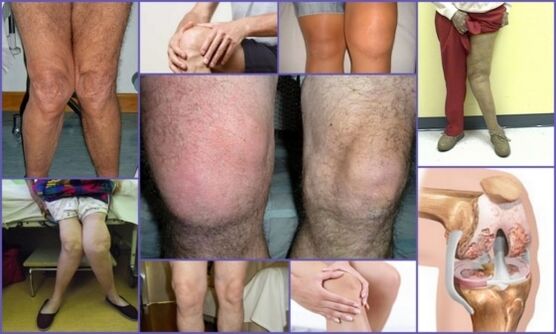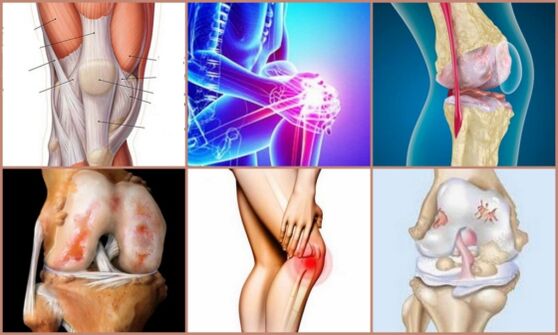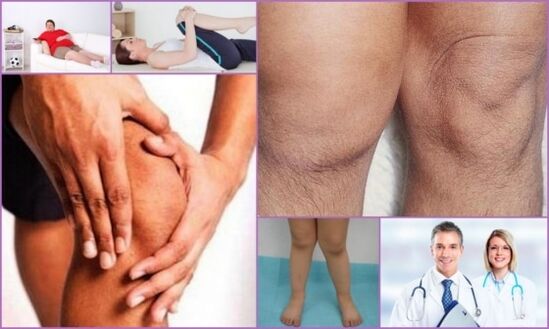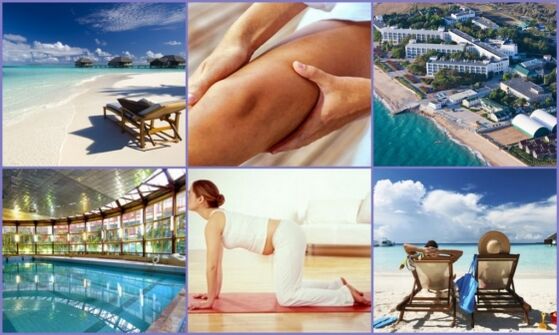Knee arthrosis is so common that it has a separate name - gonarthrosis. Another name for this disease is deforming osteoarthritis.
Arthrosis of the knee joint affects 20% of the population, its ICD-10 code is M17. Half of knee pathologies are caused by arthrosis. This is a disease in which cartilage and joint surface tissue degenerate - they break down. The joint is poorly supplied with nutrients and oxygen, its function deteriorates, and inflammation occurs. It becomes immobile and painful, the patient's quality of life decreases. Complications of arthrosis lead to a wheelchair.
Let's understand what arthrosis of the knee joint is and how to treat it. How to prevent the disease and how dangerous it is.

Causes and classification
The causes of arthrosis of the knee joint are various - mechanical damage, hereditary tendency, metabolic disorders.
The occurrence of the disease is associated with excessive stress on the knees. It is an occupational injury in many sports. People over 60 years of age with a high degree of obesity almost always have arthrosis to one degree or another due to constant microtrauma. Arthrosis refers to occupational diseases where a person has to stand for a long time or lift heavy objects. The disease can begin after rheumatoid arthritis.
The most common cause of knee arthrosis is injury. The second most common is uterine dysplasia. Inflammation caused by autoimmune pathologies is the third source of arthrosis. There are usually several reasons, one complementing the other.
Types of arthrosis of the knee joint are divided into primary and secondary, depending on the causes. If the etiology is unknown, primary arthrosis is diagnosed, and if the cause is identified, secondary arthrosis is diagnosed.
Mechanism of development
Due to the constant change in osmotic pressure, cartilage is nourished. When the joint is loaded, the viscosity of the intra-articular fluid decreases and its quantity increases. At rest, the intra-articular fluid becomes viscous and decreases in volume. Normally, these processes replace each other. Acting as a pump, the cartilage plate pushes fluid out of the joint when it is loaded, and absorbs it when it is relaxed. This is how joint tissues are nourished. When the joint is exposed to destructive effects, the pathological process manifests itself:
- If the load is large and there is no time to restore the joint, nutrition is disrupted. Cartilage becomes thinner, cracks and ulcers form on it;
- The structure of collagen fibers is disturbed, it is absorbed worse. Cartilage and patella soften, become flexible and perform their functions worse;
- Bone growths appear in the joint. The membrane of the joint capsule is irritated and inflamed;
- As a person begins to take care of the knee and move less, less intra-articular fluid is produced. Cartilage surface becomes dry and rough;
- The knee becomes less nourished, atrophies occur and its destruction accelerates.
Signs of arthrosis of the knee joint appear: it becomes immobile and pain occurs. The pain is especially severe in the morning and after prolonged immobility.

Stages of arthrosis
There are three degrees of arthrosis:
- Initial stage. The tissues have not yet been destroyed. So far, only the function of the synovial membrane is deteriorating. The composition of the intra-articular fluid has changed. The knee can no longer withstand the normal load;
- Articular cartilage and menisci begin to deteriorate. Osteophytes - bone formations - grow into bones. Inflammation and pain appear;
- A difficult stage. The supporting platform of the knee joint is deformed, the axis of the leg changes. The ligaments shorten, the joint capsule hardens. The joint is pathologically mobile, but it cannot be completely bent or straightened. Inflammation and pain are pronounced.
On a note!
At the very beginning of the disease, the muscles are intact. Their function is gradually lost. In the third stage, movement is severely restricted. Due to the change in the axis of movement, the attachment sites of the muscles change. Muscles are deformed - they are shortened or stretched, they can no longer contract normally. Nutrition of all foot tissues suffers.
Symptoms
At the beginning of the disease, the symptoms of arthrosis of the knee joint do not manifest themselves in any way and do not force the patient to consult a doctor. The patient feels fatigue and pain, but does not pay much attention to them.
The classic symptom of knee arthrosis is immobility and stiffness in the joint, pulling sensation in the popliteal region, pain after exercise. It is difficult to move in the morning or after a long period of inactivity. Relief comes after the patient stretches, massages, and walks around the knee.
After some time, the intensity and duration of the pain increases. A crisis appears in the joint, completely stopping twisting and folding. When walking, a person begins to limp - most patients turn to the doctor with this complaint. Treatment of arthrosis of the knee joint usually begins only at the second stage.
If nothing is done, action is only possible with outside help. When the patient lies down, the knee hurts less, but the pain often bothers you at night.
In the second and third stages, the knee joint is deformed - the contours of the bones are sharply defined, the lower leg is bent. If you put your hand on your knee, you will hear a creaking sound when bending and straightening. When the kneecap moves, it also creaks. Fluid accumulates in the cavity, the joint swells, and the tissues become bulging.
As the disease progresses, all symptoms become more pronounced.

Diagnostics
Diagnosis of arthrosis of the knee joint is carried out comprehensively: anamnesis is collected, laboratory and instrumental methods are prescribed.
Examination
The doctor examines the injured joint, takes measurements of the bones and the angle of bending, and determines the degree of mobility in the joints under the angle.
Analyzes
The patient is sent for a general blood test, a biochemical blood test and a general urinalysis.
x-ray
X-rays of the knee joint are the main source of information for making a diagnosis. The photo shows arthrosis of the knee joint: the joint space narrows, the cartilage is sclerotic, the bones are damaged; there is joint deformation, deposition of salts and dystrophic changes. Osteophytes are clearly visible in the picture.
Good to know!
For arthrosis of traumatic origin, X-rays are of great diagnostic value and should be performed.
Ultrasound
Ultrasound diagnosis is an informative method. Ultrasound does not replace X-rays and does not give a picture of the nature of the joint-destructive process.
MRI
Magnetic resonance imaging provides a complete picture of the disease. This is a modern and accurate research method that allows to diagnose at an early stage. The disadvantage of MRI is its high cost.
Treatment
Treatment of the knee joint for arthrosis is carried out on an outpatient basis, hospitalization is not required.
Treatment regimen:
- Reduce the load as much as possible;
- Follow the established traffic regime;
- Do therapeutic exercises.
The goal of treatment is to slow down the destruction process, prevent contractures (complete bending and straightening of the leg) and, if possible, restore the function of the joint. Staying in sanatoriums and spas during rehabilitation shows good results.

Narcotics
Only the doctor decides how to treat arthrosis of the knee joint. You cannot choose medicines independently.
Inflammation is treated with NSAIDs (non-steroidal anti-inflammatory drugs).
Good to know!
Because arthritis causes severe pain, NSAID injections provide a quick response and a sense of relief.
Modern treatment of knee arthrosis involves the use of NSAIDs from a different group. Their influence is more prominent.
If there is inflammation of the joint lining, the doctor prescribes corticosteroid hormones for intra-articular administration. Hydrocortisone, Kenalog, Diprospan relieve inflammation and pain, but have many contraindications.
If necessary, antienzyme substances are injected into the joint space - contrical, ovamin, gordox. They can significantly slow down the destructive process.
Intra-articular injections of hyaluronic acid and its preparations are also prescribed. It restores the protective and shock-absorbing properties of the synovial fluid.
Chondroprotectors are often prescribed, but there is no evidence that they help.
Physiotherapy
The newest methods of knee arthrosis treatment do not exclude proper loading. The goal of physical therapy is to provide the right amount of movement, but not overload the joint while maintaining balance. If the patient does not understand how to treat arthrosis of the knee joint - when it is necessary to protect and develop the knee at the same time, the result of other methods is drastically reduced or reduced to zero. If the patient is conscious, it is possible to get rid of the disease.
Laser therapy and physiotherapy
Laser treatment and physiotherapeutic procedures have proven to be excellent, especially if they can be started at an early stage.
Other methods
Intraosseous blockades have a therapeutic effect by disrupting the inflammatory cycle. In addition to blockade, multi-channel electromyostimulation using a special device is used.
Compresses made from homemade ointments and rubs can relieve pain and swelling.
Prostheses
If necessary, an operation is performed - the patient is fitted with an endoprosthesis of the knee joint. Modern prosthetic methods allow patients to return to sports.

Alternative and traditional medicine
Proponents of the non-traditional approach claim that it is possible to eliminate symptoms and treat arthrosis of the knee joint using only their methods - without resorting to drugs. This is kinesitherapy (a set of special exercises), ozone therapy (physiotherapy using ozone injected into the game), homeopathy, treatment with dietary supplements, manual therapy, massage.
Attention!
When using non-traditional methods, it should be remembered that their effectiveness has not been proven.
There are original methods of treatment, but opinions about them differ.
Rehabilitation and prevention
Only therapeutic exercises and measured load on the joint can restore the knee joint with arthrosis. If the patient follows all the doctor's recommendations and is ready to fight for his health by all means, in most cases the answer to the question "can arthrosis of the knee joint be treated" is positive.
Prevention consists of timely help for injuries, active movement without overloading and maintaining an optimal body mass index.
Patient opinions
Reviews of patients who have undergone traditional treatment are generally positive, but there are also negative ones.
When making a final decision about treatment, you should consult your doctor without forming an opinion based on reviews.
Medicine has learned to successfully treat joint diseases, the consequences of which inevitably lead to disability in the last century. With arthrosis of the knee joint, it is important to seek help in time to determine the stage of the disease and the degree of treatment.
























